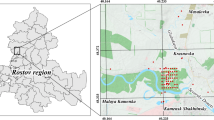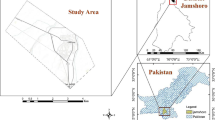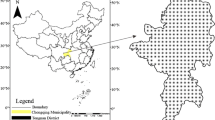Abstract
This study describes application of chemometric multi-way modeling approach to analyze the dataset pertaining to soils of industrial area with a view to assess the soil/sub-soil contamination, accumulation pathways and mobility of contaminants in the soil profiles. The three-way (sampling depths, chemical variables, sampling sites) dataset on heavy metals in soil samples collected from three different sites in an industrial area, up to a depth of 60 m each was analyzed using three-way Tucker3 model validated for stability and goodness of fit. A two component Tucker3 model, explaining 66.6% of data variance, allowed interpretation of the data information in all the three modes. The interpretation of core elements revealing interactions among the components of different modes (depth, variables, sites) allowed inferring more realistic information about the contamination pattern of soils both along the horizontal and vertical coordinates, contamination pathways, and mobility of contaminants through soil profiles, as compared to the traditional data analysis techniques. It concluded that soils at site-1 and site-2 are relatively more contaminated with heavy metals of both the natural as well as anthropogenic origins, as compared to the soil of site-3. Moreover, the accumulation pathways of metals for upper shallow layers and deeper layers of soils in the area were differentiated. The information generated would be helpful in developing strategies for remediation of the contaminated soils for reducing the subsequent risk of ground-water contamination in the study region.
Similar content being viewed by others
References
Anderson, C. A., & Bro, R. (2000). The N-way toolbox for MATLAB. Chemometrics and Intelligent Laboratory Systems, 52, 1–4.
Barbieri, P., Adami, G., Piselli, S., Gemiti, F., & Reisenhofer, E. (2002). A three-way principal factor analysis for assessing the time variability of freshwaters to a municipal water supply. Chemometrics and Intelligent Laboratory Systems, 62, 89–100.
Barbieri, P., Anderson, C. A., Massart, D. L., Predonzani, S., Adami, G., & Reisenhofer, E. (1999). Modeling bio-geochemical interactions in the surface waters of the Gulf of Trieste by three-way principal component analysis (PCA). Analytica Chimica Acta, 398, 227–235.
Bro, R. (1997). PARAFAC. Tutorial and applications. Chemometrics and Intelligent Laboratory Systems, 38, 149–171.
Bro, R., Andersson, C. A., & Kiers, H. A. L. (1999). PARAFAC2-Part II. Modeling chromatographic data with retention time shifts. Journal of Chemometrics, 13, 295–309.
Demougeot-Renard, H., & De Fouquet, C. (2004). Geo-statistical approach for assessing soil volumes requiring remediation: Validation using lead-polluted soils underlying a former smelting works. Environmental Science & Technology, 38, 5120–5126.
Durante, C., Cocchi, M., Grandi, M., Marchetti, A., & Bro, R. (2006). Application of N-PLS to gas chromatographic and sensory data of traditional balsamic vinegars of Modena. Chemometrics and Intelligent Laboratory Systems, 83, 54–65.
Einax, J. W., Zwanzinger, H. W., & Geiss, S. (1997). Chemometrics in environmental chemistry. Weinham Germany: BCH.
Faber, N., Bro, R., & Hopke, P. K. (2003). Recent developments in CANDECOMP/ PARAFAC algorithms: A critical review. Chemometrics and Intelligent Laboratory Systems, 65, 119–137.
Flaten, G. R., Grung, B., & Kvalheim, O. M. (2005). Multi-way exploration of regular environmental monitoring surveys. Chemometrics and Intelligent Laboratory Systems, 77, 104–114.
Garcia-Diaz, J. C., & Prats-Montalban, J. M. (2005). Characterization of soils irrigated with untreated urban wastewater using multiway techniques. Chemometrics and Intelligent Laboratory Systems, 76, 15–24.
Geladi, P. (1989). Analysis of multi-way (multi-mode) data. Chemometrics and Intelligent Laboratory Systems, 7, 11–30.
Gupta, P. K. (2001). Methods in environmental analysis: Water, soil and air. Agrobios (India): Jodhpur.
Henrion, R. (1994). N-way principal component analysis. Theory, algorithms and applications. Chemometrics and Intelligent Laboratory Systems, 25, 1–23.
Henrion, R., & Anderson, C. A. (1999). A new criterion for simple-structure transformations of core arrays in N-way principal component analysis. Chemometrics and Intelligent Laboratory Systems, 47, 189–204.
Kabla, C., & Singh, B. R. (2001). Fractionation and mobility of copper, lead, and zinc in soil profiles in the vicinity of a copper smelter. Journal of Environmental Quality, 30, 485–492.
Kalra, Y. P., & Manyard, D. G. (1991). Methods manual for forest soil and plant analysis. Forestry Canada, North West Region, Northern Forestry Centre, Edmonton, Alberta, Inf. Rep. NOR-X-319.
Kiers, H., Berge, J., & Bro, R. (1999). PARAFAC2: Part I. A direct fitting algorithm for the PARAFAC2 model. Journal of Chemometrics, 13, 275–294.
Kiers, H. A. L., & Mechelen, I. V. (2001). Three-way component analysis: Principals and Illustrative Applications. Psychological Methods, 6, 84–90.
Leardi, R., Armanino, C., Silvia, L., & Alberotanza, L. (2000). Three mode principal component analysis of monitoring data from Venics lagoon. Journal of Chemometrics, 14, 187–195.
Massart, D. L., Vandeginste, B. G. M., Buydens, L. M. C., Jong, S., de Lewi, P. J., & Smeyers-Verbeke, J. (1998). Handbook of chemometrics and qualimetrics: Part B’. Amsterdam: Elsevier.
Michalski, R. S., & Kaufman, K. A. (1997). Multistrategy data exploration using the INLEN system: Recent advances. Sixth International Conference on Intelligent Information Systems, Zakopane, Poland, June 1997.
Mulchi, C. L., Adamu, C. A., Bell, P. F., & Chaney, R. L. (1991). Residual heavy metal concentrations in sludge amended coastal plain soils. I. Comparison of extractants. Soil Sci Plant Anal, 22, 919–941.
Naidu, A. S., Mowati, T. C., Somayajulu, B. L. K., & Rao, K. S. (1985). Characteristics of clay minerals in the bed loads of major rivers of India. Mitt Geol-Palaont Inst Univ Hemburg, 58, 559–568.
Pravdova, V., Boucon, C., Jong, S., de Walczak, B., & Massart, D. L. (2002). Three-way principal component analysis applied to food analysis: An example. Analytica Chimica Acta, 462, 133–148.
Sielaff, K., & Einax, J. W. (2007). The application of multivariate statistical methods for the evaluation of soil profiles. Journal of Soils and Sediments, 7, 45–52.
Singh, K. P. (1997). Water quality modeling of the Ganga river and impact analysis of the treated wastewater (metals & pesticides) on health, agriculture & environmental quality of the disposal area, report submitted to NRCD. New Delhi, India: Ministry of Environment & Forests, Govt. of India, 1997.
Singh, M., Ansari, A. A., Muller, G., & Singh, I. B. (1997). Heavy metals in freshly deposited sediments of the Gomti River (a tributary of the Ganga river): Effects of human activities. Environmental Geology, 29, 246–252.
Singh, K. P., Malik, A., Singh, V. K., Basant, N., & Sinha, S. (2006b). Multi-way modeling of hydro-chemical data of an alluvial river system – A case study. Analytica Chimica Acta, 571, 248–259.
Singh, K. P., Malik, A., Singh, V. K., & Sinha, S. (2006a). Multi-way data analysis of soils irrigated with wastewater – A case study. Chemometrics and Intelligent Laboratory Systems, 83, 1–12.
Singh, K. P., Mohan, D., Sinha, S., & Dalwani, R. (2004). Impact assessment of treated/untreated wastewater toxicants discharged by sewage treatment plants on health, agricultural, and environmental quality in the wastewater disposal area. Chemos, 55, 227–255.
Sinha, S. (2003). Studies on decontamination of Cr from UASB treated tannery effluent and contaminated soil of adjoining area at Jajmau, Kanpur through phyto-remediation techniques, report submitted to NRCD. New Delhi, India: Ministry of Environment & Forests, Govt. of India, 2003.
Smilde, A., Bro, R., & Geladi, P. (2004). Multi-way analysis, in: Application in the chemical sciences, Wiley, John Wiley & Sons, Ltd., England.
Stanimirova, I., & Simeonov, V. (2005). Modeling of environmental four-way data from air quality control. Chemometrics and Intelligent Laboratory Systems, 77, 115–121.
Stanimirova, I., Zehl, K., Massart, D. L., Heyden, Y. V., & Einax, J. W. (2006). Chemometric analysis of soil pollution data using the Tucker N-way method. Anal Bioanal Chem, 385, 771–779.
Tauler, R., Lacorte, S., Guillamon, M., Cespesdes, R., Viana, P., & Barcelo, D. (2004). Chemometric modeling of main contamination sources is surface waters of Portugal. Environmental Toxicology and Chemistry, 25, 563–575.
Timmerman, M. E. (2001). Component analysis of multi-subject multivariate, longitudinal data, Ph.D. Thesis submitted to University of Groningen, The Netherlands.
Timmerman, M. E., & Kiers, H. A. L. (2003). Four simultaneous component models for the analysis of multivariate time series from more than one subject to model intraindividual and interindividual differences. Psychomtr, 68, 105–121.
Tucker, L. R. (1966). Some mathematical notes on three-mode factor analysis. Psychomtr, 31, 279–311.
Author information
Authors and Affiliations
Corresponding author
Rights and permissions
About this article
Cite this article
Singh, K.P., Malik, A., Basant, A. et al. Vertical characterization of soil contamination using multi-way modeling – A case study. Environ Monit Assess 146, 19–32 (2008). https://doi.org/10.1007/s10661-007-0056-x
Received:
Accepted:
Published:
Issue Date:
DOI: https://doi.org/10.1007/s10661-007-0056-x




